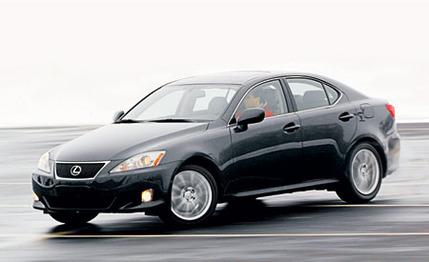
 Short Take Road Test
Short Take Road Test
In the hope of attracting more buyers, Lexus last October replaced its sales-lagging sporty-compact IS300 with two cars for 2006, the IS250 and the IS350. The more-powerful IS350 starts at $36,030 and comes with a class-leading 3.5-liter V-6 making 306 horsepower and 277 pound-feet of torque. But we think Lexus dropped the ball by not offering a manual gearbox on this little powerhouse on wheels.
If you wish to row your own, the lesser IS250 is your only choice. It starts at a more obtainable $30,580 and comes standard with a six-speed manual (the automatic is an $1170 option). And it needs it-this lesser 2.5-liter V-6 makes 204 horsepower and 185 pound-feet of torque at a lofty 4800 rpm. Math geniuses can tell you that's 102 fewer horses than the IS350.
The 2.5-liter pulls the IS to 60 mph in 7.1 seconds, two seconds slower than the 3.5-liter. Still, that's 0.1 second quicker than the fastest IS300 we'd ever tested. The IS250 jogs through the quarter-mile in 15.4 seconds at 90 mph (tying that old IS), compared with the 3.5-liter's 13.7-second sprint at 104.
Straight-line performance aside, the IS250 is a pleasure to drive, even more than its big brother. The IS350 weighs 135 more pounds than the 3465-pound IS250, and with extra weight carried over its handsome nose, the 350 understeers more than we'd like. Also, the more powerful car's suspension feels a bit overdamped and overzealous, whereas the 250's feels composed and tight. There's predictable understeer on corner entry, but a midcorner squeeze on the throttle is enough to tighten your line for a precise and pleasant blast to the next corner. For better balance, we'd take the IS250 over the IS350.
The 250's mission is to make potential buyers of a BMW 325i think twice. It's worth a look. That Bimmer starts at about a grand more ($31,595), comes with a six-speed and a 3.0-liter inline-six that makes 215 horsepower and 185 pound-feet at a low 2750 rpm. Its specs are nearly identical to the IS250's, but BMW seems to make better use of them-the German car gets to 60 mph a full second before the IS250 and 0.7 second more quickly through the quarter (14.7 seconds) at 94 mph. And the 325i feels right when pushed. Clutch engagement, shifting, braking, and steering all respond exactly as they should. On the other hand, the IS250's clutch, for one, engages too abruptly at the end of its pedal travel, which can lead to embarrassing lurches from a traffic light. So although the IS250's moves verge on those of BMW's superb 3-series, the Lexus doesn't feel quite as planted. For pure driving, BMW still has the edge.
The styling Lexus gave the new IS line turns the car from sharp to stunning. The body fits tight and low around the chassis with cool fender flares at each corner. Yet the overall shape remains graceful. And although BMW has a similarly tight design, its back-seat space is vastly better than the IS250's (41 cubic feet to the Lexus's 34, with four more inches of legroom).
Inside, the new Lexus has a more luxurious look, and the leather and plastic seem even better than those in the original model. Lexus replaced the previous IS300's chronograph-style gauge cluster with two easy-to-read electroluminescent gauges. And in this age of techno overkill, the dash layout is retro simple and intuitive. For example, the radio has just two knobs-one for volume, the other for tuning. Brilliant!
The IS250's list of standard equipment includes keyless entry and start, dual-zone climate control, a 13-speaker stereo with a six-CD changer and auxiliary input, and a power sunroof. Most of those are options on a 325i. Our tester came with the $194 Preferred Accessory package (trunk mat, cargo net, and wheel locks) and the $1290 Premium package that includes wood trim and fantastic heated and ventilated leather seats.
And for that occasional run through the woods, when you'd rather not have the electronics interfere with your tire-sliding ambitions, here's how to shut down the stability system. Start the car with the hand brake engaged. Press the brake pedal twice and hold. Engage the hand brake twice and hold. Repeat until the "skid lights" appear on the dash. The ABS does not shut off. When the engine is subsequently turned off and then switched back on, the stability control is reactivated. (Presumably, this trick works on all new Toyota and Lexus models, and it's easier than it sounds.)
The IS250 offers tremendous value to anyone looking for an affordable, sexy luxury car. But we strongly suggest a high-protein diet to beef up the motor.